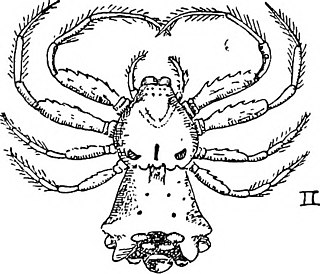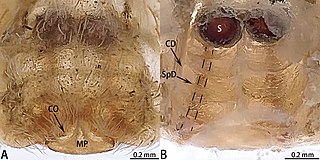
The Agelenidae are a large family of spiders in the suborder Araneomorphae. Well-known examples include the common "grass spiders" of the genus Agelenopsis. Nearly all Agelenidae are harmless to humans, but the bite of the hobo spider may be medically significant, and some evidence suggests it might cause necrotic lesions, but the matter remains subject to debate. The most widely accepted common name for members of the family is funnel weaver.

Lampshade spiders, family Hypochilidae, are among the most primitive of araneomorph spiders. There are two genera and twelve species currently recognized. Like mygalomorphs, most hypochilids have two pairs of book lungs, but like araneomorphs they have intersecting fangs, with the exception of some species which have chelicerae in an angle that is neither orthognathous or labidognathous. These long-legged spiders build typical "lampshade" style webs under overhangs and in caves. In the United States the fauna is primarily associated with the Appalachian, Rocky and California Mountains. Ten of the known species are found in these ranges, all in the genus Hypochilus. The genus Ectatosticta is found in China.

Tetrablemma is a widespread genus of armored spiders first described by Octavius Pickard-Cambridge in 1873. It only has four eyes; an unusual trait for spiders, found only here and in some species of Caponiidae, though the two are not closely related. The eyes are large, but unequal in size, closely grouped around the center of the prosoma that rises in a somewhat of a cone shape from the abdomen. They have four closely positioned spinnerets enclosed in a corneous casing.
Nesticella is a genus of spiders of the family Nesticidae. Most of its species are found in Asia—from Russia to Japan, down to Indonesia and several other islands, including New Guinea—though some species from Africa and South-America are also known. It includes a blind spider, Nesticella marapu.

Macrothele is a genus of mygalomorph spiders in the family Macrothelidae, and was first described by A. Ausserer in 1871. It is the only genus in the family Macrothelidae, and most species occur in Asia, from India to Japan, and Java, with five found in Africa, and two in Europe. The name is derived from Ancient Greek μακρός ("makro-"), meaning "big", and θηλή ("thele"), referring to the spinnerets.
Patu is a genus of dwarf orb-weavers that was first described by Brian John Marples in 1951. Two candidates for the "smallest species of spider", are in this genus, Patu digua and Patu marplesi.

Phrurolithidae is a family of araneomorph spiders first described by Nathan Banks in 1892. First included in the Corinnidae as the subfamily Phrurolithinae, later phylogenetic studies justified a separate family.

Latouchia is a genus of Asian mygalomorph spiders in the family Halonoproctidae, first described by Reginald Innes Pocock in 1901. Originally placed with the Ctenizidae, it was moved to the Halonoproctidae in 2018.

Mysmena is a genus of spiders in the family Mysmenidae, found in many parts of the world.

Phrynarachne is a genus of crab spiders first described by Tamerlan Thorell in 1869.
Pinelema is a genus of Asian long-legged cave spiders that was first described by C. X. Wang & S. Q. Li in 2012.

Singaporemma is a genus of Asian araneomorph spiders in the family Tetrablemmidae that was first described by W. A. Shear in 1978.
Sinopesa is a genus of spiders in the family Nemesiidae. It is found in China and on Ryukyu Islands in Japan. It was first described in 1995 by Raven & Schwendinger. As of 2023, it contains 8 Asian species.
Shuqiang Li is a Chinese arachnologist and a professor at the Institute of Zoology of the Chinese Academy of Sciences. Li is best known for his work with spiders and has described hundreds of new species and many genera. He is Editor in Chief of the journal Zoological Systematics.

Asianopis is a genus of Asian net-casting spiders first described by Y. J. Lin, L. Shao and A. Hänggi in 2020.
Lingulatus is a genus of araneomorph spiders in the family Phrurolithidae. It was first described by Mu & Zhang in 2022.
Edelithus is a genus of araneomorph spiders in the family Phrurolithidae. It was first described by Liu & Li in 2022.
Grandilithus is a genus of araneomorph spiders in the family Phrurolithidae. It was first described by Liu & Li in 2022.









